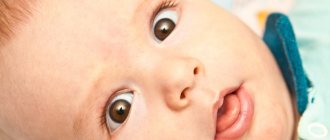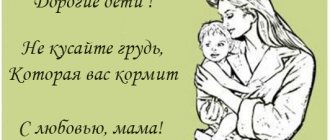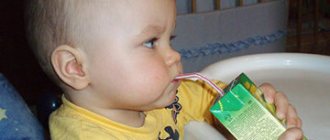Likely sources of superstition
It is believed that mirrors can accumulate information about previous owners. This information is not always positive, because in every family there are quarrels, resentments, and tragedies. The mirror surface becomes a carrier of powerful energy. The child has weak energy protection and mirror reflection can harm the fragile child’s biofield.
Interesting belief! In ancient Rome, people were sure that small children under one year old were able to see creatures from the other world, angels. A child should not be shown in mirrors because, in addition to his own reflection, he can see entities from another world.
If you study the information related to children's reflection, you can identify several sources of such signs:
- In ancient times, the influence of genetics and psychology on the formation of a child’s body was not known. Therefore, the developmental features of the child (squint, stuttering, and others) were associated with mirrors;
- the first mirror products were expensive, and a small child could break them;
- Ancient mirror technology did not display objects with 100% accuracy. The image may be warped or distorted. Seeing his image, the baby could really get scared.
But all these are just guesses and hypotheses about the origin of superstitions. In the modern world, a mirror does not pose any threat to a child.
Why, according to signs, a baby should not come into contact with the mirror
Young children should not be shown in the mirror due to possible developmental problems in the near future. Signs say that this will have a bad effect on the speech apparatus, vision, and nervous system.
Speech problems
Beliefs say that children under one year old should not look in the mirror, otherwise the child will not speak in time. Some babies can pronounce individual words at one and a half years old, others do this at two. Boys often start speaking a little later than girls.
The development of speech is closely related to the state of the brain and nervous system. Previously, mirrors were made from materials that were highly toxic. Mercury was added to the alloys. The child could inhale harmful fumes, and the toxins interfered with timely development.
There is also a mystical explanation: the baby saw his reflection, so at the energetic level his essence bifurcated. The real personality and the person in the reflection interacted with each other, and full-fledged speech was completely unnecessary for this.
Also, many infants are characterized by increased fearfulness. If a child is afraid of his reflection, he may become silent for a long time. Another problem is likely to arise in the future - stuttering. If a small child looks in the mirror at night or late in the evening, he will be able to see evil spirits there, inaccessible to the adult eye, which will frighten him.
Development of phobias
Signs say that a baby under the age of one who often looks in the mirror runs the risk of acquiring a lot of fears. This may be a fear of the dark, separation from the mother, the presence of strangers in the house, or being in crowded places. Other alarming symptoms are restless sleep, loud screaming at night, trembling.
Phobias can persist even as the baby grows up. Such children have difficulty making contact with other children and do not adapt well to nurseries when they start going to kindergarten.
If a child often cries at night and there is a suspicion that frequent contact with mirrors is to blame, you should wash him with holy water at night, wipe him with his mother’s hem and read the Lord’s Prayer. This protective ritual drives away small demons from children.
READ A crow pecked at your head: what does this sign promise and how to ward off trouble
A small child may perceive the reflection in the mirror as slightly distorted and for this reason experience fear. Sometimes the fear is so strong that parents are forced to turn to traditional healers for help. They perform magical rituals and relieve the baby from fear.
Vision problems
When a newborn is born, his visual apparatus is not yet fully functioning. In the first 2-3 weeks of life, a baby still does not know how to focus his gaze on one point, but a four-month-old baby will already be actively reaching for an object that interests him, and a six-month-old toddler will unmistakably recognize all his relatives.
It is believed that frequent play with the mirror can weaken children's vision or lead to the development of strabismus. The eye muscles are still poorly developed, the baby does not fully realize that he sees his own reflection. On a subtle level, this means that a lot of his energy flows into nowhere, his health resource is depleted, and his vision suffers first of all.
To prevent this from happening, contact with the mirror should be limited, or a protective spell should be read every time after games. The mother should take her son or daughter in her arms, turn him to face her, and with his back to the mirror, and say: “I protect my child from all bad spirits, I don’t allow him to look into the dark future. Amen". After this, you need to wipe his face with your hem.
Developmental delay
Beliefs warn young parents that playing with a child in front of a mirror can lead to the following problems:
- he will start sitting, crawling and walking late;
- will eat little and gain weight poorly;
- will become nervous and whiny.
Infants do not yet have strong energetic protection that could ward off the evil eye of people with bad intentions. If a mirror has been in the house for a long time, it has absorbed the energy of many people who have been here as guests. Most likely, their thoughts were not always pure.
It is this negative flow that can provoke a certain delay in development in a child. To avoid such moments, simply do not install a mirror in the children's room. When the baby grows a little and gets stronger, he will be able to contact mirror surfaces without any harm to the energy system.
New mirrors that were produced quite recently are considered the safest for small children. But if a mirror hung in a store for a long time, it absorbed the biofield of many customers.
Mirror signs
There are many beliefs associated with mirrors; it has been shrouded in mystery since ancient times. It is used in rituals by magicians and hypnotists. The property of reflecting objects is associated with the other world, and the mirror itself is considered the border between worlds.
Signs associated with the mirror.
- A child under 1 year old should not look into a mirror. This is fraught with fear and various developmental disorders.
- A broken display surface carries 7 years of bad luck.
- Looking into a broken mirror means health problems.
- You cannot look at your image after midnight - in addition to your reflection, you can see the other world.
- It is dangerous to use antique mirrors. They have accumulated a lot of negativity and are capable of emitting black energy.
- For any undertaking, you need to purchase a new mirror. The old has accumulated all the past negativity and will bring it into the new life.
- You can’t sit with your back to the mirror - it takes away energy and vitality.
- Reflective surfaces should not be placed in the bedroom, especially above the bed. During sleep, the human subconscious is most vulnerable to the influence of the other world.
- In a house where there is a deceased, the mirrors are covered. The soul, wandering around the house, may accidentally see its reflection and not find the afterlife.
But none of the mirror signs has scientific confirmation. Compliance with such beliefs depends on the intellectual development and breadth of a person’s horizons. Young mothers prefer not to show their children a mirror for intuitive reasons - to once again protect the child from unknown, inexplicable consequences.
Reliable fact! Initially, mercury was used in the production of mirrors . Its vapors had a detrimental effect on the fragile children's body. Prolonged inhalation of mercury vapor could cause serious health problems for the baby. Therefore, small children were not allowed near mirrors.
Possible consequences
The older generation willingly shares mirror signs with young mothers. Some do not take into account signs, hang a mirror in the children's bedroom and play educational games. But many parents avoid their child’s contact with this item, fearing the consequences.
Consequences of contact of a newborn with a mirror according to signs.
- Difficulties in development. A mirror is a magical object that can take energy from a fragile personality. During the development process, the baby will not have enough vitality for personality formation and physical growth. Difficulties in learning and communicating with peers will lead to isolation and timidity.
- Stuttering. In ancient times, there was an opinion that stuttering occurs in people who have suddenly lost their vitality. A person wants to, but cannot clearly express his thoughts. Witch doctors believed that the imaging surfaces were inhabited by demonic entities, and the newborn did not have the protective power to resist them.
- Poor health. If a newborn sees his image, constant illnesses will begin to haunt him. Such a statement can be associated with damage, the evil eye, and a ban on showing the baby to anyone. The mirror has long been prescribed magical properties; it is often used to remove the evil eye. It happens that a newborn has a weak immune system or a congenital infection that weakens his health. The child often gets sick, and doctors cannot find the cause, then they start talking about the evil eye, and attribute mirrors and other signs to it.
- Fright. The newborn does not perceive himself as a separate person. Seeing the reflection, he can get stressed and even psychologically traumatized.
- Strabismus. If a newborn sees his reflection, he will develop strabismus. Entities from the other world take away life energy from a weak baby. And strabismus was interpreted by ancient healers as a discrepancy between the desires of the subconscious and the individual due to weak internal energy.
- Delayed speech development. One of the most serious consequences of a mirror sign is a speech delay in a baby. According to legend, a child who regularly looks at a reflection can communicate silently with the world beyond the looking glass. And in the future, the subconscious does not see the need to establish contact with the outside world by making sounds.
Such nuances in the development of a child, of course, have a medical basis - genetic predisposition, intrauterine infection and others. But in earlier times, medicine was not as developed as it is now, and many diseases were unknown. Therefore, doctors associated all disorders in the development of a child with such magical objects as mirrors. This has come down to our times in the form of signs.
What pediatricians say
An infant does not understand that he is an independent person. Looking at his reflection, the baby may think that it is a stranger and burst into tears. Severe stress in particularly susceptible and restless children cannot be ruled out. Looking at yourself in the mirror at night, in semi-darkness, is fraught with insomnia or bad dreams.
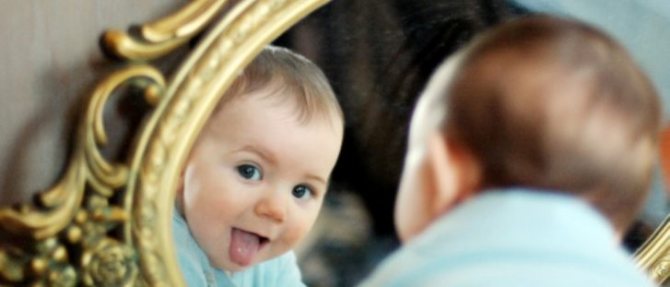
The mirror will bring tangible benefits to the baby after a year, when, seeing himself, he breaks into a smile and begins to make faces. The child understands that “someone” is repeating his movements, and over time becomes aware of his reflection.
Benefits of playing with a mirror:
- development of logical thinking, attention, imagination;
- acquaintance with the outside world and surrounding objects;
- stress resistance, adjustment of emotional background.
Parents often bring children who begin to act up to the mirror. Seeing their reflection, they switch their attention and calm down.
When should you give your child a mirror?
Already from two months, a child can focus his vision on objects, perceive them separately and examine them for several seconds. Tracking moving objects greatly develops a baby's visual motor skills. Closer to four months, active cognition of the surrounding world begins; the visual organs can identify illuminated objects. At this age, the mirror will arouse keen interest in the child. The optimal distance for children's vision is 30 cm.
Six-month-old children look at their image with interest, but do not yet associate themselves with it. By eight months, the baby begins to understand who is displayed in the mirror, brings his toys to the mirror and examines their display with curiosity.
Interesting! Although a well-known sign prohibits showing a newborn in a mirror, in reality, the visual apparatus cannot yet focus on the image. Until two months old, a child is simply not able to see anything in the mirror.
When should you give your child a mirror?
As we found out, a child up to one year old can look in a mirror. Experts generally recommend introducing your baby to this subject almost from the cradle.
- In the first half of life, the child certainly does not understand that he himself is reflected in the mirror. However, various objects reflected in this glass allow the baby to more quickly and fully understand the surrounding reality, develop more successfully, creating additional neural connections in the cerebral cortex.
- In the second half of the year, the baby gradually realizes that in the unusual object he “is” himself and his mother, who is holding him in her arms. This understanding creates an opportunity for parents:
- expand the boundaries of knowledge of the surrounding world, since the child can take a new look at familiar objects;
- captivate the baby with a new game, since children can literally spend hours looking at themselves and their mother in the mirror;
- monitor the correctness of child development, since an 8-month-old toddler should become interested in his own reflection.
A “flare” of interest in mirror glass occurs after 8 months. The child looks at his reflection and understands: I and everyone else exist!
It is curious that it is at this age that the baby begins to be afraid of strangers. And this is completely normal, because he has entered a period of self-identification.
Games with a mirror
The reflective surface serves as an excellent educational toy. The first acquaintance should be carried out carefully, observing the baby’s reaction. If any negative emotions appear, games should be postponed for a month.
- playing with a newborn. The mother brings the child in her arms to the mirror, waits until he catches the image and begins to make various movements, always voicing them. For example: “Look how I can raise my pen up”, “And this is you, you can also raise your pen up;
- We play with an older child. By the age of 8 months, children already begin to understand whose image they see. Using mirrors you can easily examine body parts. Comfortably positioned in front of the reflective surface, mom points to parts of the body, saying: “This is your nose, and this is my nose.” You can teach your child to control his body and express emotions: “Show your tongue, wave your hand.
At two years old you can play dress up. You need to put the baby in front of the mirror and start dressing him, commenting on your actions: “We’ll put a hat on his head, mittens on his hands.” The child will quickly learn to dress independently.
The sign that a newborn should not be shown in the mirror has no scientific or medical justification. Moreover, child psychologists recommend working with a child in front of a mirror, developing his psychomotor functions.
Exercises in front of a mirror
A mirror surface is an excellent educational toy, of course, provided that it is handled correctly and the age factor is taken into account. The most important thing is to stock up on a safe mirror and carefully monitor the little person’s reaction.
Games for babies under 6 months
The mirror is great for improving spatial-visual perception in young children.
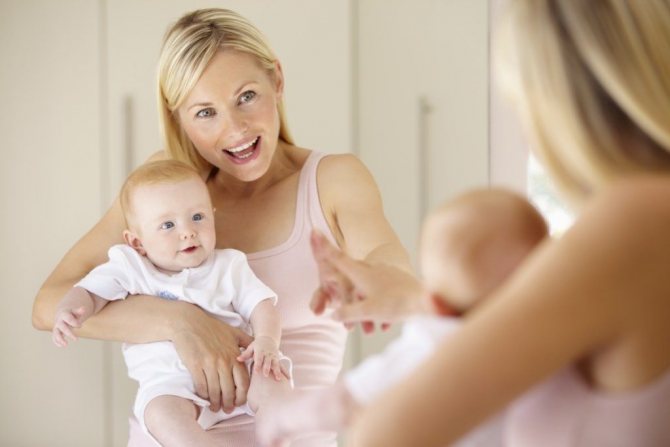
The training algorithm consists of several sequential actions:
- The baby is picked up and brought to a large mirror at the optimal distance for a newborn - 30 cm. It is necessary to wait until the baby concentrates his gaze on the reflection.
- After this, the mother smiles and, turning to the child’s reflection, softly says: “Hello, honey, it’s me, your mother. Look how I can open and close my eyes. Look how I smile." All phrases must be accompanied by appropriate actions.
- Since the baby is still too small to track the movements of his finger, the mother takes his hand and shows herself where he is in the mirror, and what she is doing at that moment.
Such games are played only with a child who is in a good mood. The baby should not experience any discomfort.
Games for babies over 6 months
When the baby understands that he is himself in the mirror opposite, you can complicate the exercises a little.
- In front of the mirror, show and name parts of the face: eyes, ears, nose, lips. This technique allows you to learn the name and location of body parts in the shortest possible time and accelerate the development of speech.
- An older child is shown mirrored objects, pictures and letters. Why is this necessary? Such a game helps to study already familiar things in a completely different way.
- Emotional exercises are another type of “mirror” games. Invite your child to look at himself in the mirror and express various emotions: smile, frown, tease. It is better to do such activities together, it will be more fun.
It's a good idea to show your child his dirty face in the mirror. If he begins to clean the reflective surface, it is necessary to explain that he should wipe his own face, in which case the dirt in the reflection will disappear. This is a very effective exercise for developing self-perception.
A mirror can also help in developing such a useful skill as dressing independently. Experts recommend putting your baby in front of a mirror before going outside so that he puts on a hat, jacket and gloves, looking at himself from the side.
